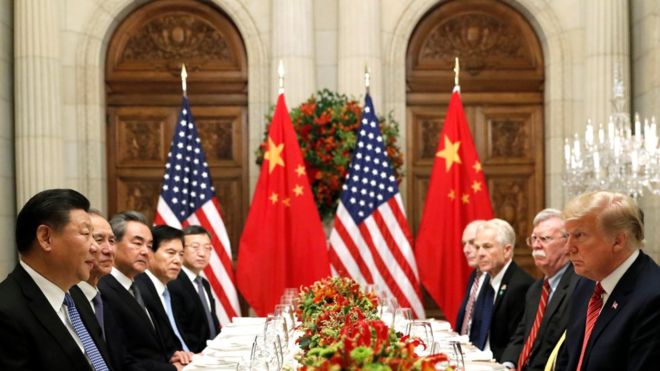
President Trump made the comments on Twitter without providing more details. The tariffs are currently set at 40%.
The move comes after the US and China reached a temporary truce in their trade war.
President Trump and Xi Jinping agreed at the G20 summit to halt new trade tariffs for 90 days to allow for talks.
The US and China have been embroiled in a trade war this year which has seen the US hit China with tariffs on $250bn (£195.9bn) worth of goods since July, and China retaliate with duties on some $110bn of US goods over the same period.
As part of this, the US imposed a 25% tariff on Chinese cars, on top of the 2.5% already in place.
China imposed a 40% tariff on US vehicle imports - much higher than the 15% it places on other trading partners.
The US says its tariff policy is a response to China's "unfair" trade practices and accuses it of intellectual property theft.
Failure to strike a deal at the G20 summit would have seen tariffs on $200bn worth of Chinese goods rise from 10% to 25% at the start of next year, and would have opened the way for tariffs on additional Chinese goods.
Relief over the agreement at the G20 pushed Asian markets higher on Monday. In China, Hong Kong's Hang Seng index jumped 2.6% and the Shanghai Composite index rallied 2.9%. Japan's Nikkei 225 index rose 1%.
"Many people suspected that there may be a more disastrous outcome, this is definitely a relief," Masamichi Adachi, senior economist at JP Morgan in Japan, said.
What was agreed at the G20?
In a statement, the White House said US tariffs on Chinese goods will remain unchanged for 90 days, but added: "If at the end of this period of time, the parties are unable to reach an agreement, the 10 percent tariffs will be raised to 25 percent."
The US said China agreed to "purchase a not yet agreed upon, but very substantial, amount of agricultural, energy, industrial, and other products from the United States to reduce the trade imbalance between our two countries".
Both sides also pledged to "immediately begin negotiations on structural changes with respect to forced technology transfer, intellectual property protection, non-tariff barriers, cyber intrusions and cyber theft", according to the White House.
Chinese Foreign Minister Wang Yi told reporters after the talks that "the principal agreement has effectively prevented further expansion of economic friction between the two countries".
He hailed "new space for win-win co-operation", while Chinese state TV said negotiations would continue.
Are tariffs still in place?
Yes. The truce prevents raising tariffs as planned on $200bn worth of Chinese goods.
But it does not remove tariffs that apply to a total of $250bn of Chinese goods targeted since July.
The truce also does not affect the existing duties China has imposed on $110bn of US goods in a tit for tat retaliation.
Will this resolve the dispute?
While the result of the G20 meeting was better than expected, it is unclear how the two countries will manage to resolve the underlying differences behind the conflict.
"There should be no wishful thinking that the truce would end the trade war between the world's two largest economies," DBS strategist Philip Wee wrote in a research note.
He said it "remains to be seen if real progress could be achieved during this narrow window to resolve the contentious issues, not just on trade, but also intellectual property."
Louis Kuijs, head of Asia economics at Oxford Economics, said while the agreement itself was "positive" the next steps remained unclear.
"Whether we will see further de-escalation or whether it is temporary reprieve continues to be very much up to a political decision in Washington DC - that will continue to make this uncertain," Louis Kuijs, head of Asia economics at Oxford Economics said.